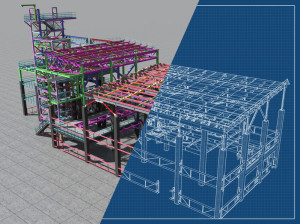 When you evaluate 3D laser scanning from a historical perspective, it very much is a study of tech development in fast-forward. A lot of the development underpinning laser scanning seemed like magic; outrageous ideas and the ingenuity to make those ideas a reality. It’s also about the race between imagination and technology, each constantly leap-frogging the other. It’s the story of a powerful set of hardware and software tools that have finally reached that optimal balance between potential and practicality. This is where we are today in the world of 3D laser scanning. And it’s about a lot more than just construction, civil engineering, or structural engineering in Utah and beyond.
When you evaluate 3D laser scanning from a historical perspective, it very much is a study of tech development in fast-forward. A lot of the development underpinning laser scanning seemed like magic; outrageous ideas and the ingenuity to make those ideas a reality. It’s also about the race between imagination and technology, each constantly leap-frogging the other. It’s the story of a powerful set of hardware and software tools that have finally reached that optimal balance between potential and practicality. This is where we are today in the world of 3D laser scanning. And it’s about a lot more than just construction, civil engineering, or structural engineering in Utah and beyond.
But, before we talk about how 3D laser scanning in modern applications is changing the construction sector, let’s go back in time to see how we got where we are and what we can learn about where we’re going.
Nascent Technologies That Would Lead to 3D Laser Scanning
It should be no surprise to anyone that the history of 3D laser scanning starts with the United States military. Most advanced technologies used in consumer or commercial applications began in a military lab (see: The Internet). In 1953, the United States military began experimenting with an optical measuring device using light and high-speed shutters. They assigned the project (and the device) the name LIDAR before lasers were even invented.
Yet, they were not the only ones hard at work on this novel new technology. While they worked on the early version of laser technology, across the pond the Ferranti Company of Scotland released an electronic probing machine for a precise measurement called a Coordinate Measuring Machine (CMM). The first to be released was a 2-axis version.
Together, these two projects would form the foundation for what we today call 3D laser scanning. Yet, the innovation did not stop there. The 1960s would see even more laser technological innovation. Building off the invention of the laser, the U.S. military upgraded the LIDAR system to integrate lasers for precise distance measurement in topographical and investigative scenarios, including portable and airborne devices. In 1963, they would develop the XM-23, which was a portable laser-measuring device that would wind up declassified and become popular in civilian and commercial production and manufacturing applications.
Interesting how at the same time we once again go across the pond, but this time to Italy, where a new 3-axis CMM had been designed. The 3-axis model offered a far more robust and reliable measuring system for physical objects.
3D Laser Scanning in the Modern Era
By the 1970s, the Italian 3-axis CMM had a remote computer control integrated into its functionality. And while the system was still too slow for highly detailed applications, the breakthrough had occurred and now others would run with it.
Time to fly back across the pond again to the University of Utah’s Computer Science Department, where they would spend a massive amount of time and effort developing computer algorithms that allowed computers to directly translate 3D models based on real-world information. In 1972, they would map the points and lines across the surface of a 1968 Volkswagen Beetle. This innovation would end up being the first digitized 3D model of a real-world object. Interestingly enough, and also in 1972, the people who would go on to found Pixar Animation Studios (Coincidence? We think not.) would use 3D computer animation to create a short film called “The Human Hand.”
The next big leap in 3D laser scanning came in the 1980s. It was called the “stripe” method. This method was far more efficient than using the “point” or “area” methods of laser scanning. It was in 1984 that Cyberware Laboratories of Los Angeles, California, released their “Head Scanner,” a stripe-based laser scanner designed to create a 3D computer image of the human head to be used for animation purposes in the entertainment industry. This same technology eventually evolved into a full-body scanner design, which is still in use today. It seems fitting that much of the world’s laser scanning technology innovation has come out of Hollywood.
The 21st-Century 3D Laser Scanning Environment
Today, the construction industry uses 3D laser scanning technologies to such a degree that they are almost taken advantage of. It’s like a carpenter with a hammer. These are things we have just become accustomed to in our industry. From BIM-related modeling and design to laser scanning software aids, 3D laser scanning technology has come a long way.
Here at McNeil Engineering, we are proud to offer 3D laser scanning and BIM modeling technologies as part of the suite of tools we use to complete some truly incredible work. Whether you have a project in Utah or beyond, let us utilize the tools of the past and the future to engineer the works of the future!








